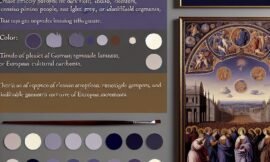Creating art is not just about the skills or imagination; the materials you use play a crucial role in bringing your artistic vision to life. Among these essential materials is art paper, a pivotal choice that can significantly influence the outcome of your work. Whether you are a watercolor artist, a sketcher, or someone exploring digital media, understanding different art paper types is crucial. This guide will delve into the characteristics of various art papers and provide insights on selecting the most suitable paper for your medium, paying particular attention to watercolors and sketching.
Understanding Art Paper: The Basics
What is Art Paper?
Art paper is specifically designed for different artistic mediums and techniques. It’s distinguished by its weight, texture, and absorbency, making it suitable for varied artistic applications. For artists, selecting the right type of paper can enhance the overall quality and effect of their artwork.
Why Paper Choice Matters in Art
The choice of paper can significantly affect the texture, color vibrancy, and durability of an artwork. For instance, rough-textured paper might be ideal for expressive work, while a smooth surface is perfect for detailed illustrations. Different papers react uniquely to mediums like watercolors or graphite, necessitating a considered selection process.

Exploring Art Paper Types
Watercolor Paper
Watercolor paper comes with a distinct set of characteristics. It’s designed to handle the water and pigment used in watercolor painting without warping or bleeding. The two primary types are hot-pressed and cold-pressed paper. Hot-pressed paper has a smooth finish, ideal for detailed work, while cold-pressed has a textured finish, excellent for holding washes and providing an organic texture to the artwork.
Sketching Paper
Sketching paper is lighter and typically features a smoother surface compared to watercolor paper. This makes it suitable for pencil, charcoal, and ink. It allows for a seamless blend of shades and strokes, which is crucial when working on detailed sketches or quick drawing exercises.
Selecting the Right Paper for Watercolors
Texture Considerations: Hot-Press vs Cold-Press
When choosing watercolor paper, the texture is an essential consideration. Hot-pressed paper, being smoother, is less absorbent, allowing for more precise control of washes and details. Conversely, cold-pressed paper enhances the textural qualities of watercolors, supporting techniques like wet-on-wet painting for atmospheric backgrounds.
Durability and Weight
The weight of the paper plays a crucial role in how it handles water. Heavier papers like 300 GSM or above are less prone to buckling under multiple washes, making them perfect for detailed watercolor works that require layering. If you’re experimenting with washes or heavy applications of paint, prioritizing durability through paper weight becomes essential.
Preparing for Sketching: The Right Paper Choice
Smooth Finish for Clean Lines
For artists focused on clean, precise strokes, papers with a smooth finish are ideal. These papers are less abrasive, allowing pencils and pens to glide across the surface effortlessly. Smooth sketching papers make it easier to create detailed pieces, whether they are architectural renderings or portrait sketches.
Textured Paper for Expressive Works
If your style leans towards expressive mark-making or softer techniques, choosing paper with a mild texture can be beneficial. This type of paper can add depth to shadows and highlights when using charcoal or graphite, making the textures a part of the artistic expression.
Trends in Art Paper for Digital Artists
Transitioning Traditional Mediums to Digital
For digital artists, the texture of traditional art papers inspires them to replicate these sensations through digital brushes and tools. As a result, modern digital applications often provide options that simulate the feel of watercolor paper or the graininess of sketching surfaces, thus bridging the gap between digital and traditional media.
Physical Media in Digital Art Prints
The production of digital art often extends into physical media, requiring high-quality art papers for fine art prints. Papers that resemble watercolor textures or photographic finishes can especially highlight digital art, ensuring the printout matches the creator’s original vision.
Combining Materials: Mixed Media Work
Choosing Versatile Paper
When working with mixed media, versatility in paper is paramount. Artists often select paper that can handle diverse applications, ranging from watercolors and inks to textured materials like acrylic gels and pastels. Papers like bristol board or mixed media paper offer the durability and adaptability needed for such diverse use.
Paper Characteristics and Media Types
Considering the physical interaction between the mediums and the paper is key for mixed media. Heavier papers can better withstand the layering and pressure applied during mixed media work, while textured surfaces can hold onto loose mediums like chalk or pastel, creating a more defined final result.
In conclusion, understanding and selecting the right art paper is essential for any artist. Whether your focus is on watercolors, sketching, or even integrating digital elements, there’s a suitable paper type designed to meet your creative needs. Consider the medium, the technique, and the desired outcome of your artwork to make an informed decision, ensuring the choice enhances, rather than hinders, your artistic process and expression.






